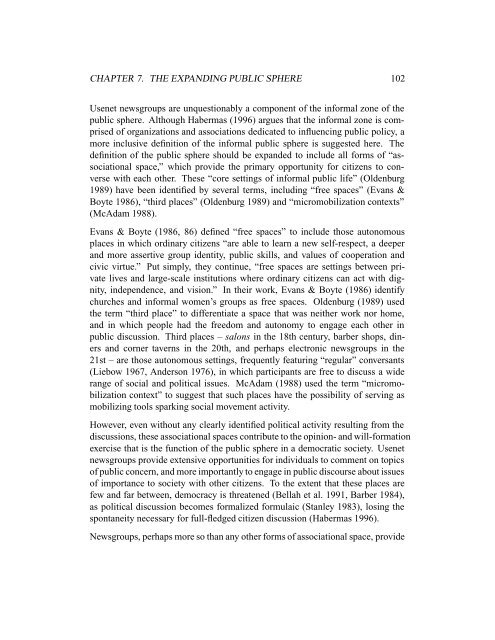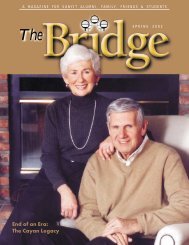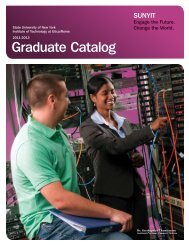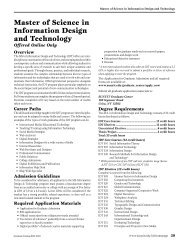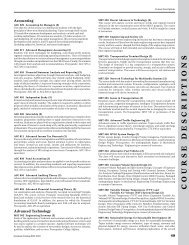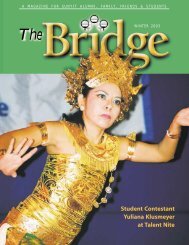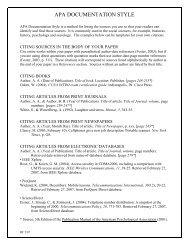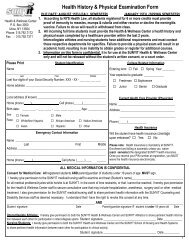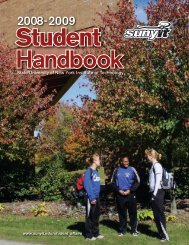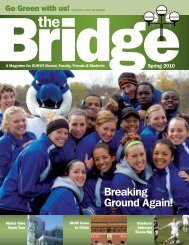Expanding the Public Sphere through Computer ... - ResearchGate
Expanding the Public Sphere through Computer ... - ResearchGate
Expanding the Public Sphere through Computer ... - ResearchGate
You also want an ePaper? Increase the reach of your titles
YUMPU automatically turns print PDFs into web optimized ePapers that Google loves.
CHAPTER 7. THE EXPANDING PUBLIC SPHERE 102<br />
Usenet newsgroups are unquestionably a component of <strong>the</strong> informal zone of <strong>the</strong><br />
public sphere. Although Habermas (1996) argues that <strong>the</strong> informal zone is comprised<br />
of organizations and associations dedicated to influencing public policy, a<br />
more inclusive definition of <strong>the</strong> informal public sphere is suggested here. The<br />
definition of <strong>the</strong> public sphere should be expanded to include all forms of “associational<br />
space,” which provide <strong>the</strong> primary opportunity for citizens to converse<br />
with each o<strong>the</strong>r. These “core settings of informal public life” (Oldenburg<br />
1989) have been identified by several terms, including “free spaces” (Evans &<br />
Boyte 1986), “third places” (Oldenburg 1989) and “micromobilization contexts”<br />
(McAdam 1988).<br />
Evans & Boyte (1986, 86) defined “free spaces” to include those autonomous<br />
places in which ordinary citizens “are able to learn a new self-respect, a deeper<br />
and more assertive group identity, public skills, and values of cooperation and<br />
civic virtue.” Put simply, <strong>the</strong>y continue, “free spaces are settings between private<br />
lives and large-scale institutions where ordinary citizens can act with dignity,<br />
independence, and vision.” In <strong>the</strong>ir work, Evans & Boyte (1986) identify<br />
churches and informal women’s groups as free spaces. Oldenburg (1989) used<br />
<strong>the</strong> term “third place” to differentiate a space that was nei<strong>the</strong>r work nor home,<br />
and in which people had <strong>the</strong> freedom and autonomy to engage each o<strong>the</strong>r in<br />
public discussion. Third places – salons in <strong>the</strong> 18th century, barber shops, diners<br />
and corner taverns in <strong>the</strong> 20th, and perhaps electronic newsgroups in <strong>the</strong><br />
21st – are those autonomous settings, frequently featuring “regular” conversants<br />
(Liebow 1967, Anderson 1976), in which participants are free to discuss a wide<br />
range of social and political issues. McAdam (1988) used <strong>the</strong> term “micromobilization<br />
context” to suggest that such places have <strong>the</strong> possibility of serving as<br />
mobilizing tools sparking social movement activity.<br />
However, even without any clearly identified political activity resulting from <strong>the</strong><br />
discussions, <strong>the</strong>se associational spaces contribute to <strong>the</strong> opinion- and will-formation<br />
exercise that is <strong>the</strong> function of <strong>the</strong> public sphere in a democratic society. Usenet<br />
newsgroups provide extensive opportunities for individuals to comment on topics<br />
of public concern, and more importantly to engage in public discourse about issues<br />
of importance to society with o<strong>the</strong>r citizens. To <strong>the</strong> extent that <strong>the</strong>se places are<br />
few and far between, democracy is threatened (Bellah et al. 1991, Barber 1984),<br />
as political discussion becomes formalized formulaic (Stanley 1983), losing <strong>the</strong><br />
spontaneity necessary for full-fledged citizen discussion (Habermas 1996).<br />
Newsgroups, perhaps more so than any o<strong>the</strong>r forms of associational space, provide


